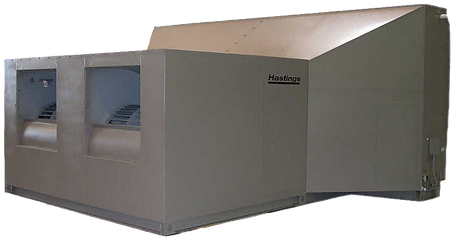

Direct Evaporative Cooling
EC Series - Direct Evaporative Cooler
Features/Applications
Space Cooling
Peak Cooling Power Shaving
Ventilation
Completely Matched Assembly with Transitions
Augment DX Cooling
Specifications
SCFM: 1,500-100,000
BTUH Cooling: Dependant Upon Wet and Dry Bulb Temperatures
Location: Outdoor
Mounting: Ground Pad or Rooftop

What is Evaporative Cooling?
Since ancient times, evaporative cooling has been used as an inexpensive and simple method of providing cooler air temperatures. Heat is absorbed whenever water is evaporated and converted to water vapor. Evaporative cooling is essentially adiabatic, following a constant wet bulb line, with no change in total heat. By passing air through or around a wetted surface, sensible heat is removed from the surrounding air in the vaporization of the water. In turn, the added water vapor increases the latent heat and the relative humidity, but retains total heat at a constant value. In contrast to compressing a refrigerant, evaporative cooling requires no mechanical work or energy and operates at considerably less cost than cooling by refrigeration.
Hastings Evaporative Cooler
Hastings evaporative air coolers provide fresh air which is continuously drawn through special wetted 12" evaporative media. The unique cross-fluted design of the media induces highly turbulent mixing of air and water for optimum heat and moisture transfer. Water flows through the length of the distribution header, is jetted up through small holes spaced along the pipe, impinged on the larger cover pipe and transmitted to he media as a fine water curtain. The media is designed so that water is constantly directed to the air entry side. This results in cooling efficiencies up to 90%. It also allows greater face velocities without water carryover.
Evaporative Cooling Considerations
As the total heat – Btu/h content- of the air in the conditioned space remains constant during the evaporative cooling process, any decrease in sensible heat is countered by an increase in latent heat. In general, the use of evaporative cooling for conventional air conditioning is limited to locations with summer design wet bulb temperature of 70 degrees or less. However evaporative cooling can be applied effectively in industrial and commercial applications with higher wet bulb design temperatures. The primary indicator of the potential effectiveness of evaporative cooling is the web bulb depression during the peak hours. Normally evaporative cooling will be practical with a wet bulb depression (entering dry bulb temperature minus entering wet bulb temperature) of 20 degrees or more. While cooling can be effected with smaller wet bulb depressions a greater number of air changes are required as well as other application considerations.
Evaporative Cooling Applications
Comfort applications
Evaporative coolers are used extensively for comfort air conditioning, rather than mechanical refrigeration, in areas with relatively dry climate conditions. A large part of western United States falls into this category. In locations having a summer design wet bulb temperature of 70 degrees or less, evaporative coolers can be used for most comfort cooling applications.
Relief Applications
Relief cooling with evaporative coolers can be effectively accomplished for industrial and hot, humid commercial environments with practically no limitations as to design wet bulb temperatures. Many commercial and industrial applications feature high internal sensible and latent loads. Often accompanied by large makeup air requirements. In most of these installations it is not economically feasible to cool with mechanical refrigeration. As evaporative coolers have both low first cost and low operating cost and in turn require 100% outside air, they can get used most successfully to provide relief cooling for these applications.
Relief or comfort cooling using evaporative coolers is accomplished in two ways. First by lowering the dry bulb temperature of the air and secondly, by the movement of air over individuals. Generally comfort cooling for hot industrial applications is achieved by either space cooling or spot cooling. Air quantities vary dependent upon wet bulb depression and the internal heat source. In addition to industrial comfort cooling and industrial process cooling, evaporative coolers provide relief in such applications as laundries and restaurant kitchens. They have also proven practical for green house as well as animal barn and poultry house cooling.